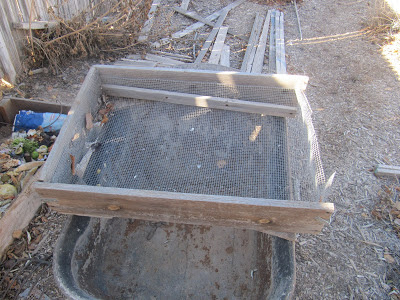It is an 8 foot hole, 12" deep and lined with plywood that I scavenged from another project. I lined it with plywood so that the dirt wouldn't fall back in. You don't want dirt in your compost, any type of compost. Dirt is inorganic material and as such not subject to the processes of organic decomposition. You will want to add you compost to the soil when it is finished "cooking". Kinda like whipped cream on a cake...you don't bake the cake with the whipped cream, but rather add it to the whipped cream after you're done baking it. It makes the cream so much better but would probably ruin it if you added it too soon. Anyway, back to the bin...you'll notice I have a lid on mine. I use the lid for at least two reasons. One is to keep the dogs and the kids and the coyotes out. The other reason is that worms are photo-phobic; without the lid, the top portion of the material wouldn't get eaten. And third (okay so there are three reasons) is that the lid keeps the sun off the bin, thus reducing evaporation. And here's what the inside of my bin looks like.
If you look closely, you may notice that there is a lot of "raw" material on one side and not so much on the other. I do this to make harvesting easier. By putting a bunch of wet gooey stuff on one side, and allowing the other side to decompose and dry, there is more material that can pass more easily through the screen.
"The screen?", you ask.
You will need a screen, a wheelbarrow, and a shovel. I don't like a screen too small, I don't see the point. So I use a square of hardware cloth that has 1/2" webbing. I only screen the compost because I am lazy on the front end--I am not too particular about contaminates that may end up in the bin; and partly to screen out the harder to digest materials: the avocado pits, and turkey bones and whatnot. The wheelbarrow and the shovel don't need discussion, do they?
I shovel the dry material...
onto the screen..
and shake it all about...
When I am done shaking and grooving ( a good set of music on the iPod helps), I am left with the finished material...
and the stuff too big to pass through the scree.
After I sort out the trash from the other big stuff**, I put the bigger stuff back on top of the other raw feed stocks--a sort of cover on the material.
This will help it to stay moist and allow it to continue to decompose, but also will remind me to add material to the other side. As an aside benefit, it is also a good indicator of the worm activity--in the spring, when the vermi-metabolism kicks in, the level almost visibly drops from day to day. After the cover has been spread level, I am ready to start adding material to the freshly cleaned out side. In the spring, I'll do it all over again.
**I strongly recommend experimenting with various feed stocks...who knows what you'll come up with. Some of the strangest things I've discovered is that cardboard milk containers have a very thin plastic lining on the inside. Worms eat the cardboard but leave the lining. Most cotton t-shirts aren't--there is always a significant percentage of inorganic fabric. Toothpaste boxes (not the tubes, but rather the cardboard packaging) are really not so much cardboard. And those little stickers on organic fruit--the ones that say "organic fruit"-- aren't. I love pulling out countless plastic "windows" left over from junk mail envelopes. Eggshells don't decompose.








